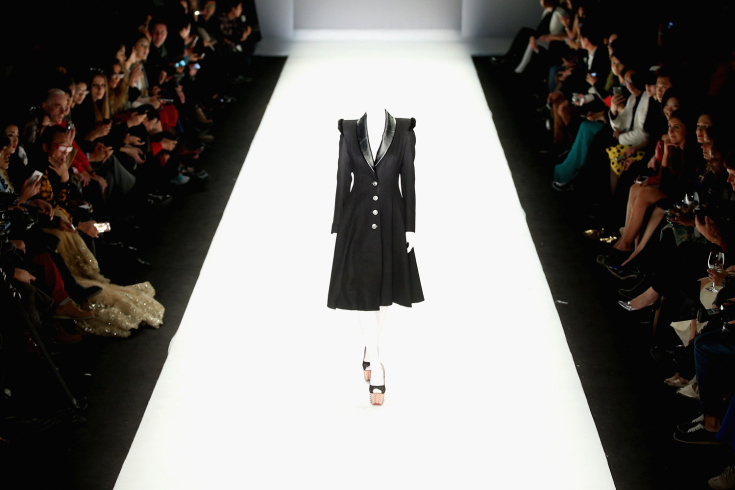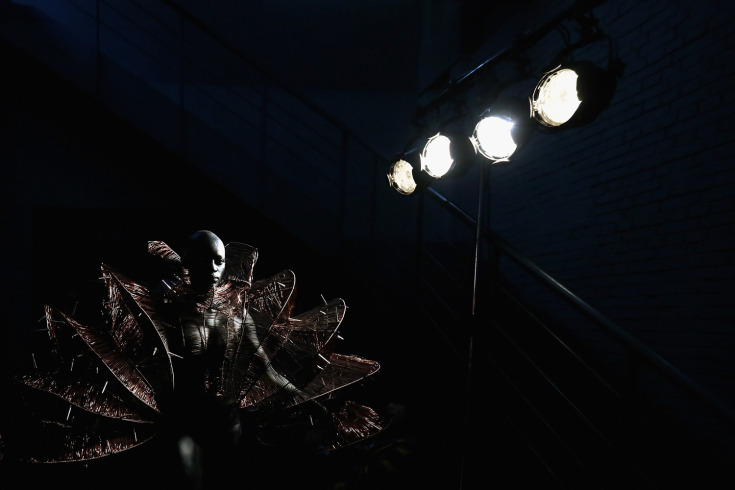Perhaps it’s progress if a woman now can be an empty suit.
And it’s certainly gets to the bare bones of the fashion show, where the models are there solely to display the clothes. Living mannequins, they are not supposed to be seen as individuals, or even as persons, so why not use an artistic technique to capture that social fact and put it on display? This specific technique of overexposing the film has even been used before on the runway, and I guess it bears repeating–this time at the Mercedes-Benz China Fashion Week Spring/Summer 2014 show.
The picture is striking, of course, and that alone is a prompt to ask what might be on display or if the image has anything unexpected to say. Actually, quite a bit is there: we see the dress, and how the model has been reduced to pure functionality, and an audience that we can imagine could quickly become accustomed to actually seeing models that way, and a set of modernist design principles, and an environment created for the express purpose of showcasing aesthetic appeal and innovation, and a commercial system (back to the audience again) that will convert those experiments into a global network of clothing manufacture and sales, and a history of fashion with citations of 1940s couture (the dress again) and Orientalist accessories (the shoes), and with that an allusion to photography’s black & white past. . . . That’s a pretty good haul for a single photo.
And there might be one more thing. That reference to “Mercedes-Benz” provides the clue, because the auto industry continues to be a solid example of how commodity production can be hidden under fashionable styling. No, cars are not like wheat or iron, but they’re closer than you might think, not least when the few differences among them are a small part of an industry built on robotics and branding. And even if I’m wrong about cars, I think I’m right about the truth that is being exposed in this photo: Once incorporated into a global system of mass production, the human being becomes commodified–one in a series of uniform units as interchangeable and decontextualized as a model on the runway.
I’m not going to argue the point today, not least because I’m channeling a tradition of social thought that is part of a larger debate about modernity, and that doesn’t have all the answers anyway. What is interesting is that the idea can be presented to vividly in a photograph of a routine event. (Yes, even Fashion Week is routine, occurring throughout the year around the globe.) Furthermore, another image from the same event by the same photographer adds yet another dimension to the argument.
Same show, even the same collection (Hu Sheguang Haute Couture), except now we are backstage. This would seem to offer an additional series of contrasts with the first image: darkness instead of too much light, figure present instead of absent, primitive instead of moderne, African instead of Orientalist detailing, encumbered or even caged instead of in empty, abstract space, etc. True enough, but also on behalf of the same insight.
What you see here is the return of the human figure, but now encased in an apparatus instead of a dress, and situated downward, in darkness, almost as if in an infernal factory. She appears to be immobilized, as if awaiting activation. She may be subjectively immobilized as well, although it probably would be worse if she were self-conscious. If the first design draws on the past to inflect the present, this one alludes to a more distant past to suggest a future without enlightenment.
In both images, however, our fate is the same: to become defined entirely by the system of production. Erased or encased as needed, the only requirement is to be interchangeable and thus individually expendable. And the result is the same whether working in the full glare of the spectacle or hidden deep in the hive.
Fortunately, absolute domination is impossible and the modern world-system is much more complex than social theory. Even so, fashion houses and photojournalism have developed an intriguing working relationship on our behalf: images such as these expose tendencies that already are at work, and possibly refashioning what it means to be human.
Photographs by Feng Li/Getty Images.


Discussion